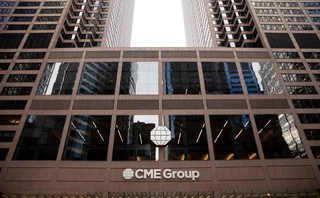
No going back
The credit crisis has highlighted a series of failings in risk management systems and processes at banks. Hans Blommestein of the OECD describes the steps banks must take to continue to benefit from using derivatives in the long run

Many of the difficulties during the credit crisis have been attributed to derivatives. Collateralised debt obligations (CDOs) referenced to credit default swaps (CDSs) on asset-backed securities were hit particularly hard by the rise in defaults in the US subprime mortgage market. As writedowns within investment banks mushroomed, firms found it increasingly difficult to unwind illiquid derivatives positions, contributing further to the problems. At the same time, derivatives have been blamed for contributing to increased leverage in the financial system.
There continue to be concerns regarding counterparty credit risk and the settlement of outstanding derivatives positions. A major worry is that a key provider of credit protection could default at the same time as a popular reference entity, leaving counterparties with no insurance on their exposures and scrambling to replace positions. Of particular concern is the downgrades of major monoline bond insurers, putting at risk the cover on CDO tranches written by these entities via CDS contracts.
Despite these problems, the view that derivatives are largely to blame is not universal. While some observers have pointed to the demise of Bear Stearns in March (and before that the collapse of Connecticut-based hedge fund Long-Term Capital Management (LTCM) in 1998) as evidence of structural weaknesses in over-the-counter derivatives, others have argued that the OTC market coped well at a time of heightened volatility.
Nonetheless, the crisis has raised doubts about the effectiveness of risk management systems used by banks. Highly sophisticated financial institutions were confident their models would be able to deal with market corrections. But systems failed to anticipate how banks would perform in the event of a complete drying up of market liquidity, and severely underestimated how they would be affected by heightened market stress.
Against this backdrop, I will assess the reasons why banks' business plans and risk management systems failed, as well as the required preconditions that need to be in place to enable firms to fully benefit from complex derivatives in the long run.
The risk paradox
The widespread and still growing use of derivatives is shaping a revolutionary new banking landscape, characterised by complex links with capital markets. This landscape enables an ever wider range of financial and non-financial companies to manage risks more effectively. In turn, the efficient allocation of risk has led to a huge improvement in the creation of value for investors.
However, this financial landscape is characterised by more complex products and markets, a higher level of systemic risk and increased financial fragility. The growing importance of derivatives for risk management and the leveraging of investment positions has contributed to the emergence of a complex, multi-layered intermediation system. This includes off-balance-sheet market value structures, which constituted an important part of a lightly regulated, 'shadow' banking landscape. A recent study estimates the size of this portion of the US banking system was around $5.9 trillion in 2007, compared with $9.4 trillion for the regulated part of the market.
And, as shown during the credit crisis, even sophisticated market participants might at times have difficulties understanding the nature of these new products and markets. Consequently, risks may be seriously mis-priced. Moreover, the sheer complexity of derivatives instruments, coupled with consolidation in the financial industry, has made it increasingly hard for regulators and bankers to assess levels of risk.
The popularity of the originate-and-distribute model means risk has been distributed to a far wider range of investors, some of which do not fall under the auspices of regulators. Bear Stearns and LTCM were at the centre of complex webs of trades with other players in the financial markets that were extremely hard to unravel. As a result, systemic risk was felt to be higher than before, prompting regulators to engineer orderly rescue operations of both firms.
In this derivatives-connected, ultra-complex financial landscape, it is not just commercial banks that have a potential systemic-sensitive dimension, but also hedge funds, investment banks and other financial institutions such as private equity firms and insurance companies. Andrew Lo, Harris & Harris group professor at the MIT Sloan School of Management, argues the credit crisis has shown that the "economy is much more sensitive to shocks in the hedge fund sector than ever before. This is proof positive that systemic risk has increased."
In other words, a wider range of financial institutions are considered 'too complex to fail'. This makes it even harder to control moral hazard situations than under the 'too large to fail' doctrine.
These two faces of the derivatives/risk management revolution define what I call the risk paradox. Clearly, sound risk management systems (incorporating as building blocks a wide range of derivatives) are essential to mitigate the severity of the risk paradox. However, the crisis has shown that implementing effective risk management systems is much harder than most banks and regulators had envisaged. Indeed, before the crisis, it had already been noted that not all banks had adopted a rigorous approach to assessing risk and profitability. Cut-throat competition had prompted some dealers to slash margins to maintain market share, even on some complex products. In 2004, former US Federal Reserve chairman Alan Greenspan said "one of the more painful lessons learned in the 1970s and 1980s is that accepting narrow or nonexistent spreads in order to retain market share is a losing strategy". The current crisis has shown these lessons were not taken on board.
A sound risk management system should therefore be fully integrated with a bank's business model. Enterprise-wide risk management systems play a key role in the preparation and execution of business strategies, thereby strengthening banks' competitive position. But the credit crisis revealed a major gap between this theory and risk management practices.
An important contributing factor to the recent turmoil was structural weaknessess in the risk management of the securitisation business. Typical features of the associated business models are some combination of maturity transformation, leveraging of balance sheets and mark-to-market valuations. Given these characteristics, balance-sheet risk management by banks should have been able to deal with complex interactions between changes in asset values, leverage and liquidity risk. Unfortunately, many banks' risk management systems failed and were not able to deal adequately with these interactions and the related risks (liquidity, market, concentration and pipeline risks).
More attention to liquidity risk means: incorporating liquidity facilities into internal liquidity management; consolidation of off-balance-sheet (special-purpose) vehicles; and a greater role for stress tests and contingency plans in addressing liquidity problems. Other specific weaknesses include stress-testing practices, contingency funding plans, management of on- and off-balance-sheet activity, capital budgeting plans, valuation procedures and contingent commitments.
Moreover, risk management systems (including those based on internal and external credit ratings) also failed in a more generic sense. Maintaining volumes and compensation for expected losses became the driving force in the sector, even though the real threat arose from the potential for unexpected losses due to the combination of risk factors built into subprime and other originate-and-distribute business models. In addition, failure to consolidate information on enterprise-wide exposures and to supplement these with effective risk controls at the enterprise level undermined the ability to take strategic risk decisions.
On top of risk management failures, there were also more general flaws with new business models. These models reflect a new hybrid type of banking system based on strong and complex links with capital markets, which I called in an earlier study a 'relationship-cum-market-based banking system' - for example, the originate-and-distribute model (based on links to capital markets, the use of conduits and securitised credit). The current crisis has put the spotlight on deep-seated problems within these business models. They have not passed the credit cycle test and are therefore in urgent need of a fundamental reassessment - in particular, those involving off-balance-sheet vehicles and securitised credit.
Although banks have already indicated they will reduce their structured finance activities, securitisation as a business (including the originate-and-distribute model) is unlikely to disappear. The advantages of pooling assets and tranching liabilities are manifold and have not gone away. The originate-and-distribute model potentially has beneficial effects through its positive impact on one or more financial market functions, including the ability to sustain a given level of credit with less capital, and the creation of more complete credit markets. Moreover, the securitisation of loans can, in principle, lead to a better allocation of risks by reducing the concentration of exposures associated with loan portfolios.
However, banks will need to put risk management systems in place that not only lead to a more realistic (re)pricing of complex financial instruments on their balance sheets, but also a fundamental review of both the logic of risk-adjusted pricing, as well as the architecture of market value structures. For example, it seems clear that structured investment vehicles (SIVs) need to incorporate less leverage and larger liquidity provisions than in the past. Indeed, managers and sponsors of SIVs acknowledge the so-called senior debt investor base is unlikely to return to the sector in the absence of fundamental changes to the business model. As a result, the securitisation market will probably be characterised by smaller deal sizes and simpler structures in future. What is also needed is more transparency about the risks in securitised products, including potential correlations of underlying assets and the process of establishing ratings.
The future of complex derivatives
The resulting revised or new business strategies will need to go beyond the immediate crisis to mitigate on a structural basis the risk paradox, thereby reducing the likelihood of future credit crises. In fact, these changes are taking place against the backdrop of massive losses, which are forcing many banks to take assets back on to their balance sheets, leading to a reintermediation of risks. This, in turn, is prompting radical solutions such as capital injections by strategic investors, dividend cuts, sales of asset/business units and/or a full-scale break-up or merger with a stronger bank.
Derivatives will continue to play a key role in these revised business strategies, provided six mutually reinforcing key pillars are in place.
- Banks and other financial institutions need to continue to move to high(er) standards of risk awareness and risk management, which means having in place systems for risk monitoring and control that allow financial institutions to deal effectively with all sorts of risks. This includes the use of consolidated (also called integrated or enterprise-wide) risk management systems.
Consolidated risk management involves quantification of risk across the various business segments of sometimes very complex, diversified financial firms. Moreover, the crisis has shown that risk control systems need to be able to account for a lot more tail correlation between asset classes than is normally assumed in the calibration of variance/covariance matrices, as well as additional scenarios in which correlations breakdown. This requires a greater role for economic scenario generators and stress tests. The resulting improvement in risk management is essential for making better-informed decisions about how to invest scarce capital and human resources.
- More effective tools and procedures for risk-managing derivatives positions are also necessary to mitigate the seriousness of the risk paradox. The following are essential for market participants to benefit from derivatives: operational aspects such as a well-functioning clearing, trade matching and confirmation infrastructure, and an adequate legal and regulatory framework. Market participants should ensure transparency, product suitability, prevention of market abuse and best execution.
Risks associated with the use of derivatives - in particular operational, market, credit and liquidity risk - should be identified and managed adequately, notably via appropriate stress testing. A better understanding of risks related to derivatives and market value structures is also essential. For example, the credit crisis has raised serious concerns about risks associated with separating origination from distribution risk by using credit derivatives. Lack of transparency is also an important weakness. The crisis demonstrates that regulators and market participants may not always understand where risks are hidden, or may lack the information to accurately assess credit and liquidity risk.
- The infrastructure of the OTC derivatives market warrants special attention due to its size and ultra-complex links to all parts of the financial system. This includes management of counterparty risk, cash settlement of credit derivatives contracts and delays in trade confirmations. The industry and regulators face, to some degree, a trade-off between efficiency and stability in the OTC market.
The greatest advantage of the OTC market is that it offers bilateral, tailored solutions. The downside is that the lack of transparency, trade discrepancies and backlogs, valuation disputes and bilateral credit risk leads to a vast amount of risk with potentially disastrous unwinding effects. A greater involvement of exchanges or central counterparties would lead to more stability in the form of enhanced transparency over trading positions, as well as independently valued and systematically margined positions. This, in turn, means no valuation disputes, missed margin calls or bilateral credit risk, and no room for discrepancies and backlogs.
However, there are limits to these institutional solutions. Listing or clearing of contracts requires some degree of standardisation. This will be technically and/or economically harder for more complex OTC products. For example, swaps need to be tailored to specific circumstances to be effective hedges. Moreover, many OTC contracts are more than $1 million in size, making them very hard to trade widely on an exchange.
- Supervisory and regulatory agencies need to have the necessary capacity to monitor risk-taking by banks and assess the quality of the management of that risk in a more complex market environment. They have a great interest in controlling systemic risk via mitigating moral hazard associated with too-complex-to-fail situations. The move to more risk-sensitive capital regimes such as Basel II is therefore a response to managing risks in the new banking landscape more effectively. The main objective of a more risk-sensitive capital framework is to produce meaningful measures of risk relative to capital. A related goal of prudential oversight is to ensure reliable information is available to support the efficient functioning of the price discovery process.
However, the credit crisis has raised many questions about the robustness of several pillars of the new financial landscape. For example, in the wake of the problems, rating agencies have been accused of a lack of diligence in the ratings process, conflicts of interest, weaknesses in methodologies (and models), and a lack of transparency and accountability. This, in turn, raises the question of whether rating agencies meet the credibility, independence, objectivity and transparency criteria required by Basel II.
Huge losses due to the failure of risk management systems also raise the question of whether internal ratings generated by banks can be trusted. Additional supervisory changes are needed over the treatment of liquidity risk, while higher capital charges for complex structured credit products and the strengthening of capital requirements in the trading book are necessary. These are essential steps in reducing moral hazard situations associated with the stronger and more complex links among financial institutions under the de facto new too-complex-to-fail doctrine.
- International accounting standards should be able to support sophisticated risk management procedures used by banks. Not only should these new accounting guidelines be aligned to sound risk management procedures, but they need to be consistent with the supervisory objectives across the financial services sectors. However, the crisis has shown some of the more complex parts of the financial landscape sector, such as structured credit markets, are exposed to valuation problems. It is therefore urgent for regulators to assess the appropriateness of accounting rules governing asset valuation (in particular for debt instruments) and the use of off-balance-sheet vehicles. It has also been argued that a new accounting system is needed because derivatives are currently not adequately incorporated on corporate balance sheets. Market participants also need to broaden valuation options for structured investments when market liquidity disappears.
- A more robust financial system also requires that banks and other players strengthen all aspects of their business models, including the structured finance and securitisation businesses. This includes avoiding reward practices that encourage extreme risk-taking, as well as eliminating perverse incentives that may lead to insufficient screening and monitoring of borrowers.
Conclusion
In the short term, many banks will need to revise their business models, reduce leverage, raise capital and shed non-core business. Some have indicated they will leave the structured product business. Regulators are likely to curb leverage, while large users of derivatives have recently reported major losses. All these steps may reduce the (short-term) demand for some categories of derivatives. However, from a longer-term perspective, the scope for the further transfer of risks is enormous, and this creates a wide range of opportunities for all sorts of derivatives markets to continue to expand rapidly.
But to reap the full benefits of an open and increasingly complex financial landscape, it is essential the above six conditions are fulfilled. When properly implemented (and, evidently, this is easier said than done), the seriousness of the risk paradox will be mitigated, with market participants facing a win-win strategy in which complex derivatives will continue to play a central role in the efficient allocation of risk and capital. At the same time, there is a better chance that systemic financial fragility will stay within safe boundaries and that moral hazard associated with too-complex-to-fail situations will be kept at an acceptable level.
Hans Blommestein is the PricewaterhouseCoopers professor of finance at Tilburg University, the Netherlands, and head of the capital market programme at the OECD in Paris. The views expressed are personal and do not represent those of the institutions with which the author is affiliated. Email: Hans.blommestein@oecd.org
REFERENCES
Bank for International Settlements, 2008
Basel Committee on Banking Supervision announces steps to strengthen the resilience of the banking system
April 16
Bank of England, 2008
Financial stability report
Number 23, April
Bernanke B, 2008
Financial markets, the economic outlook, and monetary policy
Remarks at the Women in Housing and Finance and Exchequer Club Joint Luncheon, Washington DC, January 10
Blommestein H, 2000
The changing nature of risk and the challenges to sound risk management in the new global financial landscape
OECD Financial Market Trends 75, March
Blommestein H, 2005a
Can Basel II and IFRS get on
Financial Regulator 10(1), June
Blommestein H, 2005b
The price of innovative thinking
Financial Times, Mastering Risk, September 23
Blommestein H, 2006
The future of banking
SUERF Studies, 2006/2
Blommestein H, 2007
The growing complexity of the links between banks and capital markets
In The New Banking Economics, edited by Olivier Pastre, Hans Blommestein, Esther Jeffers and Gael de Pontbriand, Edward Elgar
Blommestein H, 2008a
Grappling with uncertainty
Financial Regulator 12(4), March
Blommestein H, 2008b
Difficulties in the pricing of risks in a fast-moving financial landscape (a methodological perspective)
Journal of Financial Transformation 22, March
Blommestein H, U Das, A Harwood, C Pazarbasiogl and A Silva, 2008
Use of derivatives for debt management and domestic debt market development: key conclusions
Financial Market Trends 94, OECD
Campbell A, 2008
VAR counts
Risk January, pages 68-71
Deutsche Bundesbank, 2007
Financial stability review
November
Greenspan A, 2004
Banking
Remarks at the American Bankers Association Annual Convention, New York, New York, October 5
Knight M, 2008
Some reflections on the future of the originate-to-distribute model in the context of the current turmoil
Speech at the Euro 50 Group Roundtable, London, April 21
Rowe D, 2006
From VAR to stress testing
Risk December, page 87
Rowe D, 2008a
Where the buck stops
Risk January, page 86
Rowe D, 2008b
Broaden valuation options
Risk June, page 89
Trichet J-C, 2007
Global capital - surrender of national policies? Lessons from the recent events in credit markets
Speech at the 17th Frankfurt European Banking Congress, November 23
Tucker P, 2007
Money and credit: banking and the macroeconomy
Speech at the Monetary Policy and the Markets Conference, London, December 13
Wood D, 2008
Clearing the way ahead
Risk June, pages 18-22
Only users who have a paid subscription or are part of a corporate subscription are able to print or copy content.
To access these options, along with all other subscription benefits, please contact info@risk.net or view our subscription options here: http://subscriptions.risk.net/subscribe
You are currently unable to print this content. Please contact info@risk.net to find out more.
You are currently unable to copy this content. Please contact info@risk.net to find out more.
Copyright Infopro Digital Limited. All rights reserved.
As outlined in our terms and conditions, https://www.infopro-digital.com/terms-and-conditions/subscriptions/ (point 2.4), printing is limited to a single copy.
If you would like to purchase additional rights please email info@risk.net
Copyright Infopro Digital Limited. All rights reserved.
You may share this content using our article tools. As outlined in our terms and conditions, https://www.infopro-digital.com/terms-and-conditions/subscriptions/ (clause 2.4), an Authorised User may only make one copy of the materials for their own personal use. You must also comply with the restrictions in clause 2.5.
If you would like to purchase additional rights please email info@risk.net
More on Risk management
Many banks ignore spectre of SVB in liquidity stress tests
In ALM Benchmarking exercise, majority of banks have no internal tests focusing on stress horizons of less than 30 days
Quant Finance Master’s Guide 2026
Risk.net’s guide to the world’s leading quant master’s programmes, with the top 25 schools ranked
ALM Benchmarking: explore the data
View interactive charts from Risk.net’s 46-bank study, covering ALM governance, balance-sheet strategy, stress-testing, technology and regulation
Staff, survival days, models – where banks split on ALM
Liquidity and rate risks are as old as banking; but the 46 banks in our benchmarking study have different ways to manage them
CME faces battle for clients after Treasuries clearing approval
Some members not ready to commit to 2026 start date; rival FICC enhances services
AI and the next era of Apac compliance
How Apac compliance leaders are preparing for the next era of AI-driven oversight
Responsible AI is about payoffs as much as principles
How one firm cut loan processing times and improved fraud detection without compromising on governance
Op risk data: Low latency, high cost for NSE
Also: Brahmbhatt fraud hits BlackRock, JP Morgan slow to shop dubious deals. Data by ORX News






